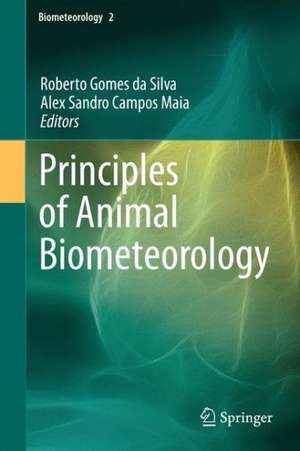Principles of Animal Biometeorology: Biometeorology, cartea 2
Autor Roberto Gomes da Silva, Alex Sandro Campos Maiaen Limba Engleză Hardback – 12 noi 2012
| Toate formatele și edițiile | Preț | Express |
|---|---|---|
| Paperback (1) | 944.19 lei 6-8 săpt. | |
| SPRINGER NETHERLANDS – 14 dec 2014 | 944.19 lei 6-8 săpt. | |
| Hardback (1) | 954.31 lei 6-8 săpt. | |
| SPRINGER NETHERLANDS – 12 noi 2012 | 954.31 lei 6-8 săpt. |
Preț: 954.31 lei
Preț vechi: 1163.80 lei
-18% Nou
Puncte Express: 1431
Preț estimativ în valută:
182.62€ • 189.51$ • 152.65£
182.62€ • 189.51$ • 152.65£
Carte tipărită la comandă
Livrare economică 17-31 martie
Preluare comenzi: 021 569.72.76
Specificații
ISBN-13: 9789400757325
ISBN-10: 9400757328
Pagini: 288
Ilustrații: XXIV, 264 p.
Dimensiuni: 155 x 235 x 21 mm
Greutate: 0.7 kg
Ediția:2013
Editura: SPRINGER NETHERLANDS
Colecția Springer
Seria Biometeorology
Locul publicării:Dordrecht, Netherlands
ISBN-10: 9400757328
Pagini: 288
Ilustrații: XXIV, 264 p.
Dimensiuni: 155 x 235 x 21 mm
Greutate: 0.7 kg
Ediția:2013
Editura: SPRINGER NETHERLANDS
Colecția Springer
Seria Biometeorology
Locul publicării:Dordrecht, Netherlands
Public țintă
Upper undergraduateCuprins
Contents.- 1. The Environment.- 2. Basic Physical Mechanisms.- 3. Thermal Balance and Thermoregulation.- 4. Heat Exchange Between Animals and Environment: Mammals and Birds.- 5. Heat Exchange Between Animals and Environment: Aquatic Mammals.- 6. Shade and Shelter.- 7. Thermal Stress Indexes.- 8. Special Methods.- Index.
Textul de pe ultima copertă
Principles of Animal Biometeorology presents a thorough examination of the atmospheric environment in which animals live, and an equally comprehensive account of the processes of thermal energy exchanges between organisms and environment, with particular focus on tropical climates. The book begins by describing in detail the mechanisms of energy exchange – radiative, convective, conductive and evaporative – together with techniques for their determination. The discussion extends to the importance of CO2, ozone and methane, together with that of aerosol pollutants and the evolution of atmospheric CO2.
Subsequent chapters apply the results of the biophysical methods to mammals, birds and aquatic animals. Discussion includes problems of shelter and shade for animals in tropical environments and techniques for the thermal evaluation for shelters and for several tree types. The details of heat exchange between animals and the environment are presented, in separate chapters covering Mammals and Birds and Aquatic Mammals. A chapter on Shade and Shelter describes the importance of shade for animals, factors of shade efficiency, the protections offered by shelter and methods of calculating the protection afforded by both shade and shelter. A Special Methods chapter offers a variety of techniques for evaluating cutaneous and respiratory evaporation, and practical methods for sampling of hairs and the evaluation of hair coat characteristics.
The text is further illuminated by numerous relevant tables, diagrams and mathematical formulae.
Subsequent chapters apply the results of the biophysical methods to mammals, birds and aquatic animals. Discussion includes problems of shelter and shade for animals in tropical environments and techniques for the thermal evaluation for shelters and for several tree types. The details of heat exchange between animals and the environment are presented, in separate chapters covering Mammals and Birds and Aquatic Mammals. A chapter on Shade and Shelter describes the importance of shade for animals, factors of shade efficiency, the protections offered by shelter and methods of calculating the protection afforded by both shade and shelter. A Special Methods chapter offers a variety of techniques for evaluating cutaneous and respiratory evaporation, and practical methods for sampling of hairs and the evaluation of hair coat characteristics.
The text is further illuminated by numerous relevant tables, diagrams and mathematical formulae.
Caracteristici
Discusses processes of thermal energy exchange between animals and the environment, with a special focus on tropical climates Describes numerous methods for observing and measuring thermal exchange, for both land and aquatic organisms Includes methods for sampling hairs, for evaluating shade in trees and in shelters, and cutaneous and respiratory evaporation Includes supplementary material: sn.pub/extras













